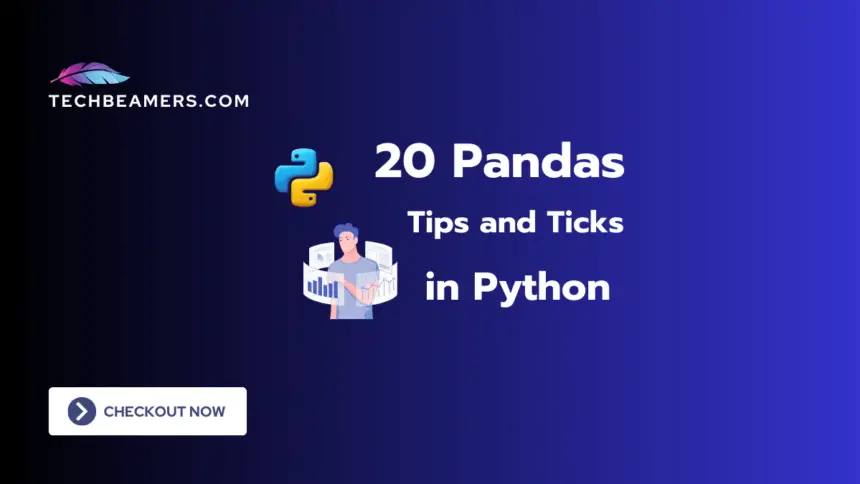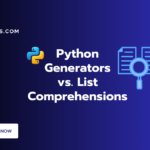Welcome to this Python tutorial including Pandas tips and tricks! In this guide, we’ll share 20 practical techniques to make your data tasks easier and improve your Python data analysis. Whether you’re new or experienced, these tips will help you become more efficient in using Pandas for data manipulation. Let’s dive in and explore the world of Pandas together, focusing on simplicity and real-world use.
Check Out Pandas Tips and Tricks for Python
Explore the below Pandas tips and tricks for efficient data tasks. Find solutions to common challenges, and enhance results. Whether new or experienced, leverage these tips for effective Pandas data analysis.
1. Importing Pandas and Reading Data
Start by bringing in Pandas, your helpful tool for working with data in Python. With Pandas, you can easily read data from different formats like CSV, Excel, or SQL databases, laying the groundwork for effective and user-friendly data analysis.
import pandas as pd
# Example: Reading a CSV file
data = pd.read_csv('your_data.csv')2. Quick Data Overview
Quickly get to know your data by using head() and tail(). These functions show the first and last few rows, giving you a snapshot of how your data is structured. This brief overview helps you make better-informed decisions in your analysis.
# Display first 5 rows
print(data.head())
# Display last 5 rows
print(data.tail())Apply the above Pandas tips to swiftly grasp data structure using head() and tail() functions.
3. Checking for Missing Data
Before starting your analysis, it’s important to find and deal with missing values. The isnull().sum() method shows how many values are missing, helping you decide whether to fill in missing data or remove it. Taking this proactive step keeps your analysis accurate and reliable.
# Check for missing data
print(data.isnull().sum())You can utilize these Pandas tips on handling missing values with isnull().sum() for informed decisions.
4. Renaming Columns in Pandas
Make your dataset easier to understand by changing column names. Use the rename() method to make labels clearer, ensuring each column is named clearly. This simple step makes your analysis much easier to read and understand.
# Rename columns
data.rename(columns={'old_name': 'new_name'}, inplace=True)5. Filtering Data
Easily get specific parts of your data by using filters. Boolean indexing, as shown here, lets you select data based on certain conditions. This focused method simplifies your analysis, concentrating on the most important information.
# Filter data where 'column' is greater than 10
filtered_data = data[data['column'] > 10]6. Sorting Data
Arrange your data for better understanding by sorting based on one or more columns. Use the sort_values() method to organize data in ascending or descending order, making data analysis more effective. This structured arrangement makes it easier to spot patterns and trends in your data.
# Sort data by 'column' in ascending order
sorted_data = data.sort_values(by='column')You can organize your dataset using Pandas tips with sort_values() for effective data analysis.
7. Dropping Columns
Make your DataFrame simpler by getting rid of extra columns. Use the drop() method to remove columns, creating a cleaner and more focused dataset. This cut in unnecessary information not only speeds up analysis but also helps in clearer visualization.
# Drop 'unnecessary_column'
data.drop(columns=['unnecessary_column'], inplace=True)8. Handling Duplicates
Keep your data reliable by finding and removing duplicate rows. The drop_duplicates() method ensures each unique observation stays singular in your dataset. Getting rid of duplicates ensures accurate and trustworthy analysis.
# Drop duplicate rows
data.drop_duplicates(inplace=True)9. GroupBy in Pandas
Find important patterns in your data by grouping based on a specific column and using aggregate functions. The groupby() method, along with functions like mean(), helps summarize your data effectively. This method simplifies complex datasets, giving you a broad overview of the information.
# Group by 'column' and calculate mean
grouped_data = data.groupby('column').mean()10. Merging DataFrames
Merge data from different places using merge(). Pick a common column and select the merge type (inner, outer, left, or right) to smoothly bring data together. This combination consolidates information for a complete analysis.
# Merge two DataFrames on a common column
merged_data = pd.merge(df1, df2, on='common_column', how='inner')It is easy to improve your data analysis by applying Pandas tips on merging datasets with merge() function.
11. Handling DateTime Data
Work with date and time easily by converting columns to the datetime format. The pd.to_datetime() method makes this simple, giving you a standard representation of time data. This standardization ensures your analysis and visualization of time-related trends are consistent.
# Convert 'date_column' to datetime format
data['date_column'] = pd.to_datetime(data['date_column'])12. Handling Categorical Data
Get your data ready for machine learning by turning categorical variables into numbers. The get_dummies() function does this, making sure your data works well with different algorithms. This change is crucial for making datasets that are ready for machine learning.
# Convert categorical variable to numerical using get_dummies
encoded_data = pd.get_dummies(data, columns=['categorical_column'])You can boost machine learning readiness with Pandas tips: use get_dummies() to encode categorical variables efficiently.
13. Reshaping Data with Pivot Tables
Change your data to make it easier to analyze with pivot tables. The pivot_table() method rearranges your data, making it more structured and better for exploring insights. This reshaping is especially helpful when you’re dealing with complex datasets.
# Create a pivot table
pivot_table = data.pivot_table(index='index_column', columns='column_to_pivot', values='value_column', aggfunc='mean')14. Applying Functions to DataFrames
Add your own touch to data tasks by using custom functions on your DataFrame. The apply() method makes it easy to apply functions to each element in a column efficiently. This customization lets you make specific transformations based on your analysis needs.
# Apply a custom function to each element in 'column'
data['column'] = data['column'].apply(lambda x: custom_function(x))15. Handling Outliers
Find and handle outliers using statistical methods. The Z-score, shown here, is a strong metric for removing data points that are far from the average. Managing outliers like this ensures that your statistical analysis isn’t affected by extreme values.
Also Read – How to Get the Average or Mean of a Column in Pandas
# Identify and filter outliers using Z-score
z_scores = (data['column'] - data['column'].mean()) / data['column'].std()
filtered_data = data[(z_scores < 3) & (z_scores > -3)]16. Creating New Features
Make your dataset better by adding new features based on existing ones. This can give you more insights and boost machine learning models. Creating new features adds depth to your analysis, possibly revealing hidden patterns.
# Create a new feature by combining existing ones
data['new_feature'] = data['feature1'] * data['feature2']17. Working with MultiIndex DataFrames
Explore complex datasets easily by understanding MultiIndexing. This method means setting multiple columns as an index, letting you do advanced and structured data exploration. MultiIndexing makes it simpler to work with data that’s organized hierarchically.
# Create a MultiIndex DataFrame
multi_index_data = data.set_index(['index_column1', 'index_column2'])18. Changing Data Types
Save memory by changing data types appropriately. The astype() method lets you convert columns to types that use less memory, making data storage efficient. This optimization is especially important when dealing with large datasets.
# Convert 'numeric_column' to integer type
data['numeric_column'] = data['numeric_column'].astype('int32')19. Handling Large Datasets
Process big datasets efficiently by using chunking. The read_csv() function reads data in chunks, making operations manageable and memory-efficient. This chunking method helps analyze large datasets without overwhelming system resources.
# Process data in chunks
chunk_size = 1000
for chunk in pd.read_csv('large_data.csv', chunksize=chunk_size):
process(chunk)20. Exporting Cleaned Data
Keep your cleaned data safe by saving it to a new file. The to_csv() method lets you store your DataFrame as a CSV file, making sure your carefully cleaned data is ready for later use. This step is important for keeping your analysis accurate and sharing insights with others.
# Save cleaned data to a new CSV file
data.to_csv('cleaned_data.csv', index=False)Wrap Up Pandas Tips in Python
With these Pandas tips and tricks, you’ll make data tasks easier and pave the way for insightful analysis. Whether cleaning messy data, merging datasets, or prepping for machine learning, Pandas offers powerful and user-friendly solutions.
Python for Data Science
Check this Beginners’s Guide to Learn Pandas Series and DataFrames.
If you want us to continue writing such tutorials, support us by sharing this post on your social media accounts like Facebook / Twitter. This will encourage us and help us reach more people.
Happy Coding,
Team TechBeamers









